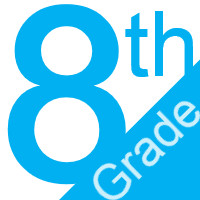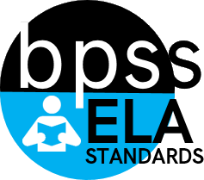8th Grade English
 Standards Glossaries
Standards Glossaries
| K Grade English | 1st Grade English | 2nd Grade English |
 Standards Glossaries
Standards Glossaries
| 3rd Grade English | 4th Grade English | 5th Grade English |
 Standards Glossaries
Standards Glossaries
| 6th Grade English | 7th Grade English | 8th Grade English |
 Standards Glossaries
Standards Glossaries
| 9th Grade English | 10th Grade English | 11th Grade English | 12th Grade English |
 Standards Glossaries
Standards Glossaries
| HS Journalism | HS Speech |
| (W) Writing |
ELA-08.W.01
Student Learning Targets:Knowledge Targets
Reasoning Targets
Skills (Performance) Targets
Product Targets
Proficiency Scale
ResourcesWebsites Vocabulary | ||||||||||||||||||||||||||||||||||||||||
ELA-08.W.02
Student Learning Targets:Knowledge Targets
Reasoning Targets
Skills (Performance) Targets
| ||||||||||||||||||||||||||||||||||||||||
| Score | Description | Sample Activity |
|
| 4.0 | In addition to Score 3.0, the student demonstrates in-depth inferences and applications regarding more complex material that go beyond end of instruction expectations. | - | |
| 3.5 | In addition to Score 3.0 performance, the student demonstrates in-depth inferences and applications regarding the more complex content with partial success. | ||
| 3.0 | “The Standard.” The student demonstrates no major errors or omissions regarding any of the information and processes that were end of instruction expectations. The student can:
|
- | |
| 2.5 | The student demonstrates no major errors or omissions regarding the simpler details and processes (Score 2.0 content) and partial knowledge of the more complex ideas and processes (Score 3.0 content). | ||
| 2.0 | The student demonstrates no major errors or omissions regarding the simpler details and processes but exhibits major errors or omissions regarding the more complex ideas and processes (Score 3.0 content). The student can:
|
- | |
| 1.5 | The student demonstrates partial knowledge of the simpler details and processes (Score 2.0 content) but exhibits major errors or omissions regarding the more complex ideas and procedures (Score 3.0 content). | ||
| 1.0 | With help, the student demonstrates a partial understanding of some of the simpler details and processes (Score 2.0 content) and some of the more complex ideas and processes (Score 3.0 content). | - | |
| 0.5 | With help, the student demonstrates a partial understanding of some of the simpler details and processes (Score 2.0 content) but not the more complex ideas and processes (Score 3.0 content). | ||
Resources
Websites
Vocabulary
ELA-08.W.03
Student Learning Targets:Knowledge Targets
Reasoning Targets
Skills (Performance) Targets
Product Targets
Proficiency Scale
ResourcesWebsites Vocabulary | ||||||||||||||||||||||||||||||||||||||||
ELA-08.W.04
Student Learning Targets for Grade 8 ELA:Knowledge Targets
Reasoning Targets
Skills (Performance) Targets
Product Targets
Student Learning Targets for Grade 8 Reading Pro:Reasoning Targets
Skills (Performance) Targets
Product Targets
Rubric for Grade 8 ELA:Click here -> Narrative writing Rubric Click here -> Argumentative writing Rubric Click here -> Informative writing Rubric Resources for GradeWebsites Vocabulary Proficiency Scale for Grade 8 Reading Pro:
ResourcesWebsites
Vocabulary
| ||||||||||||||||||||||||||||||||||||||||
ELA-08.W.05
Student Learning Targets:Knowledge Targets
Reasoning Targets
Skills (Performance) Targets
Product Targets
Proficiency Scale
ResourcesWebsites Vocabulary | ||||||||||||||||||||||||||||||||||||||||
ELA-08.W.06
Student Learning Targets:Knowledge Targets
Reasoning Targets
Skills (Performance) Targets
| ||||||||||||||||||||||||||||||||||||||||||||
| Score | Description | Sample Activity |
|
| 4.0 | In addition to Score 3.0, the student demonstrates in-depth inferences and applications regarding more complex material that go beyond end of instruction expectations. | - | |
| 3.5 | In addition to Score 3.0 performance, the student demonstrates in-depth inferences and applications regarding the more complex content with partial success. | ||
| 3.0 | “The Standard.” The student demonstrates no major errors or omissions regarding any of the information and processes that were end of instruction expectations. | - | |
| 2.5 | The student demonstrates no major errors or omissions regarding the simpler details and processes (Score 2.0 content) and partial knowledge of the more complex ideas and processes (Score 3.0 content). | ||
| 2.0 | The student demonstrates no major errors or omissions regarding the simpler details and processes but exhibits major errors or omissions regarding the more complex ideas and processes (Score 3.0 content). | - | |
| 1.5 | The student demonstrates partial knowledge of the simpler details and processes (Score 2.0 content) but exhibits major errors or omissions regarding the more complex ideas and procedures (Score 3.0 content). | ||
| 1.0 | With help, the student demonstrates a partial understanding of some of the simpler details and processes (Score 2.0 content) and some of the more complex ideas and processes (Score 3.0 content). | - | |
| 0.5 | With help, the student demonstrates a partial understanding of some of the simpler details and processes (Score 2.0 content) but not the more complex ideas and processes (Score 3.0 content). | ||
| 0.0 | Even with help, the student demonstrates no understanding or skill. | - | |
Resources
Websites
Vocabulary
ELA-08.W.07
Student Learning Targets for 8th ELA:Knowledge Targets
Reasoning Targets
Skills (Performance) Targets
Product Targets
Proficiency Scale for ELA 8:
ResourcesWebsites Vocabulary Student Learning Targets for 8th Communications:Knowledge Targets
Reasoning Targets
Skills (Performance) Targets
Proficiency Scale for ELA 8:Click HERE to view the proficiency scale. | ||||||||||||||||||||||||||||||||||||||||
ELA-08.W.08
Student Learning Targets for 8th ELA:Knowledge Targets
Reasoning Targets
Skills (Performance) Targets
Product Targets
Proficiency Scale for 8th ELA
ResourcesWebsites Vocabulary Student Learning Targets for 8th Communications:Knowledge Targets
Skills (Performance) Targets
Product Targets
Proficiency Scale for 8th Communications:Click HERE to view proficiency scale. | ||||||||||||||||||||||||||||||||||||||||||||
ELA-08.W.09
Student Learning Targets:Knowledge Targets
Reasoning Targets
Skills (Performance) Targets
| ||||||||||||||||||||||||||||||||||||||||||||
| Score | Description | Sample Activity |
|
| 4.0 | In addition to Score 3.0, the student demonstrates in-depth inferences and applications regarding more complex material that go beyond end of instruction expectations. | - | |
| 3.5 | In addition to Score 3.0 performance, the student demonstrates in-depth inferences and applications regarding the more complex content with partial success. | ||
| 3.0 | “The Standard.” The student demonstrates no major errors or omissions regarding any of the information and processes that were end of instruction expectations. | - | |
| 2.5 | The student demonstrates no major errors or omissions regarding the simpler details and processes (Score 2.0 content) and partial knowledge of the more complex ideas and processes (Score 3.0 content). | ||
| 2.0 | The student demonstrates no major errors or omissions regarding the simpler details and processes but exhibits major errors or omissions regarding the more complex ideas and processes (Score 3.0 content). | - | |
| 1.5 | The student demonstrates partial knowledge of the simpler details and processes (Score 2.0 content) but exhibits major errors or omissions regarding the more complex ideas and procedures (Score 3.0 content). | ||
| 1.0 | With help, the student demonstrates a partial understanding of some of the simpler details and processes (Score 2.0 content) and some of the more complex ideas and processes (Score 3.0 content). | - | |
| 0.5 | With help, the student demonstrates a partial understanding of some of the simpler details and processes (Score 2.0 content) but not the more complex ideas and processes (Score 3.0 content). | ||
| 0.0 | Even with help, the student demonstrates no understanding or skill. | - | |
Resources
Websites
Vocabulary
ELA-08.W.10
Student Learning Targets:Knowledge Targets
Reasoning Targets
Skills (Performance) Targets
| ||||||||||||||||||||||||||||||||||||||||||||
| Score | Description | Sample Activity |
|
| 4.0 | In addition to Score 3.0, the student demonstrates in-depth inferences and applications regarding more complex material that go beyond end of instruction expectations. | - | |
| 3.5 | In addition to Score 3.0 performance, the student demonstrates in-depth inferences and applications regarding the more complex content with partial success. | ||
| 3.0 | “The Standard.” The student demonstrates no major errors or omissions regarding any of the information and processes that were end of instruction expectations. | - | |
| 2.5 | The student demonstrates no major errors or omissions regarding the simpler details and processes (Score 2.0 content) and partial knowledge of the more complex ideas and processes (Score 3.0 content). | ||
| 2.0 | The student demonstrates no major errors or omissions regarding the simpler details and processes but exhibits major errors or omissions regarding the more complex ideas and processes (Score 3.0 content). | - | |
| 1.5 | The student demonstrates partial knowledge of the simpler details and processes (Score 2.0 content) but exhibits major errors or omissions regarding the more complex ideas and procedures (Score 3.0 content). | ||
| 1.0 | With help, the student demonstrates a partial understanding of some of the simpler details and processes (Score 2.0 content) and some of the more complex ideas and processes (Score 3.0 content). | - | |
| 0.5 | With help, the student demonstrates a partial understanding of some of the simpler details and processes (Score 2.0 content) but not the more complex ideas and processes (Score 3.0 content). | ||
| 0.0 | Even with help, the student demonstrates no understanding or skill. | - | |
Resources
Websites
Vocabulary



 Strand (W)
Strand (W)